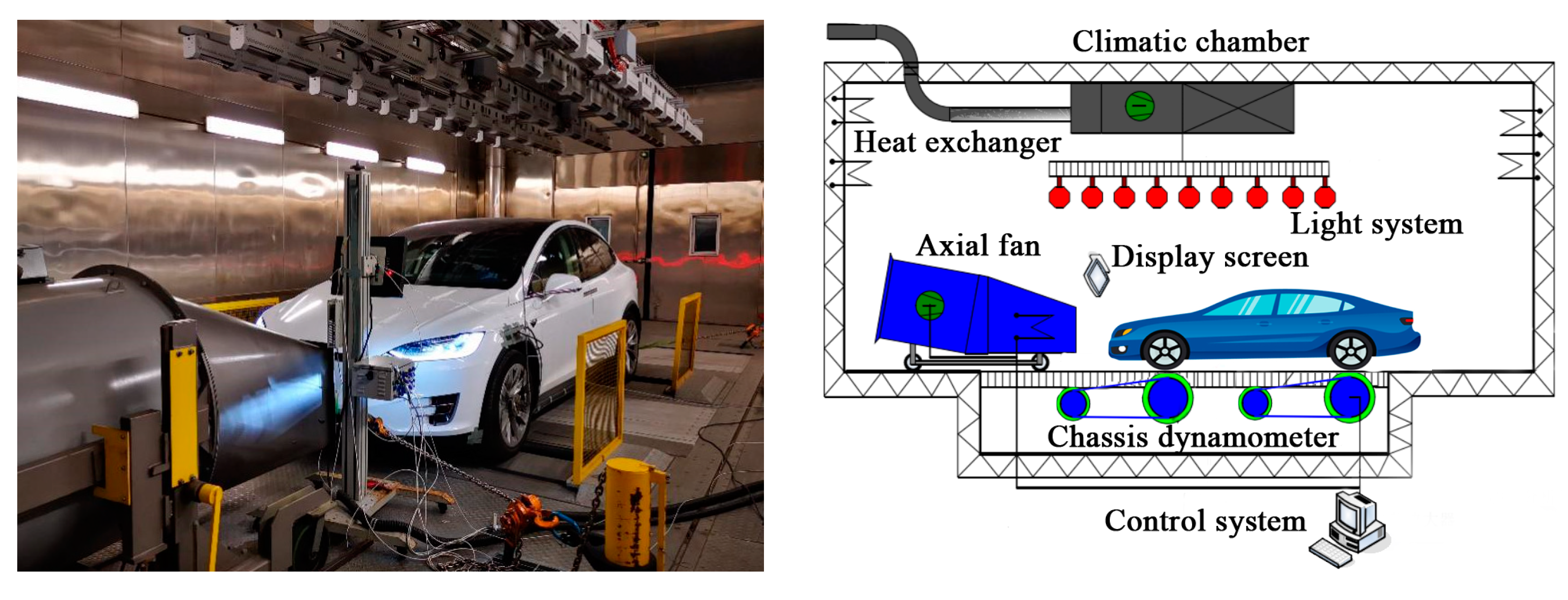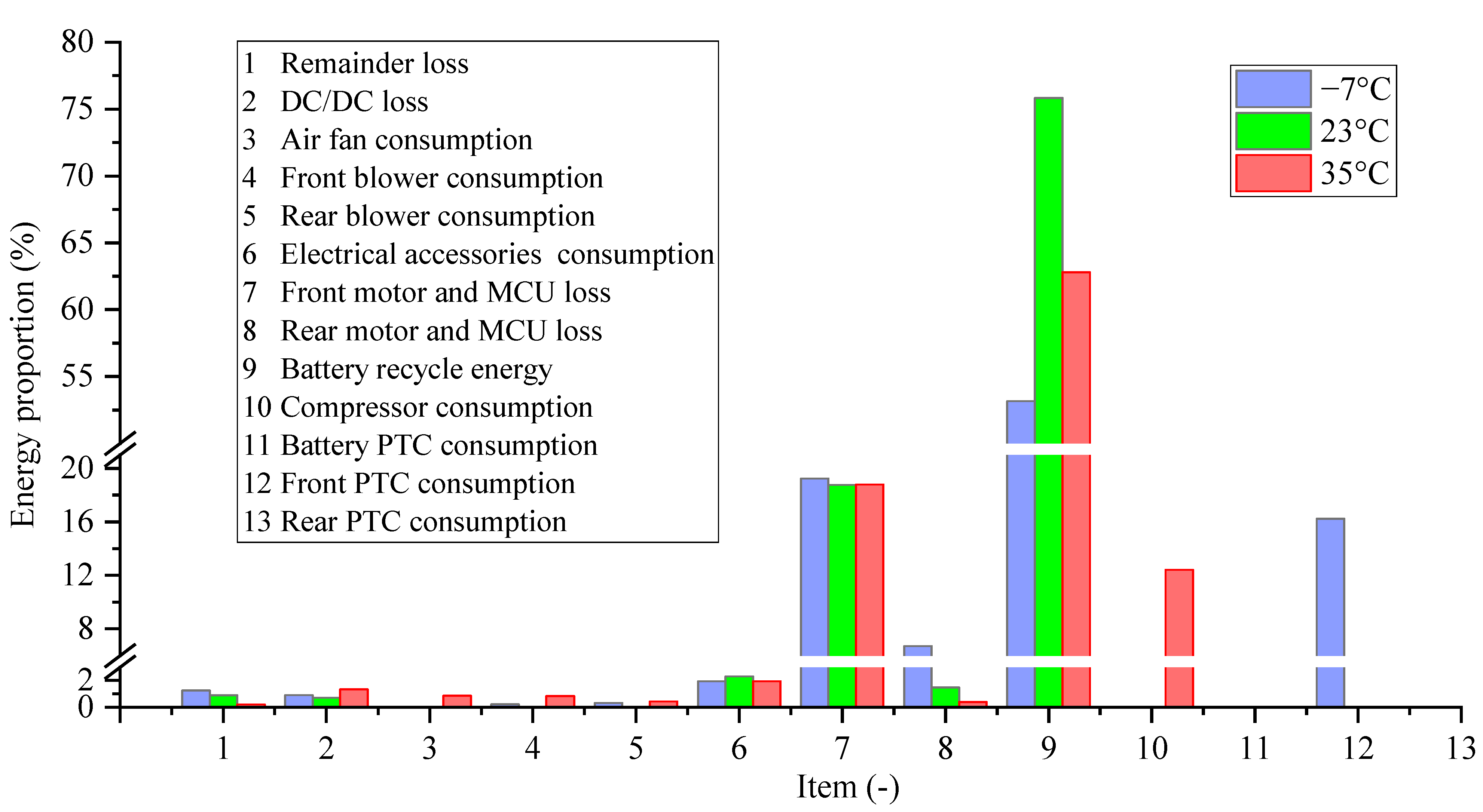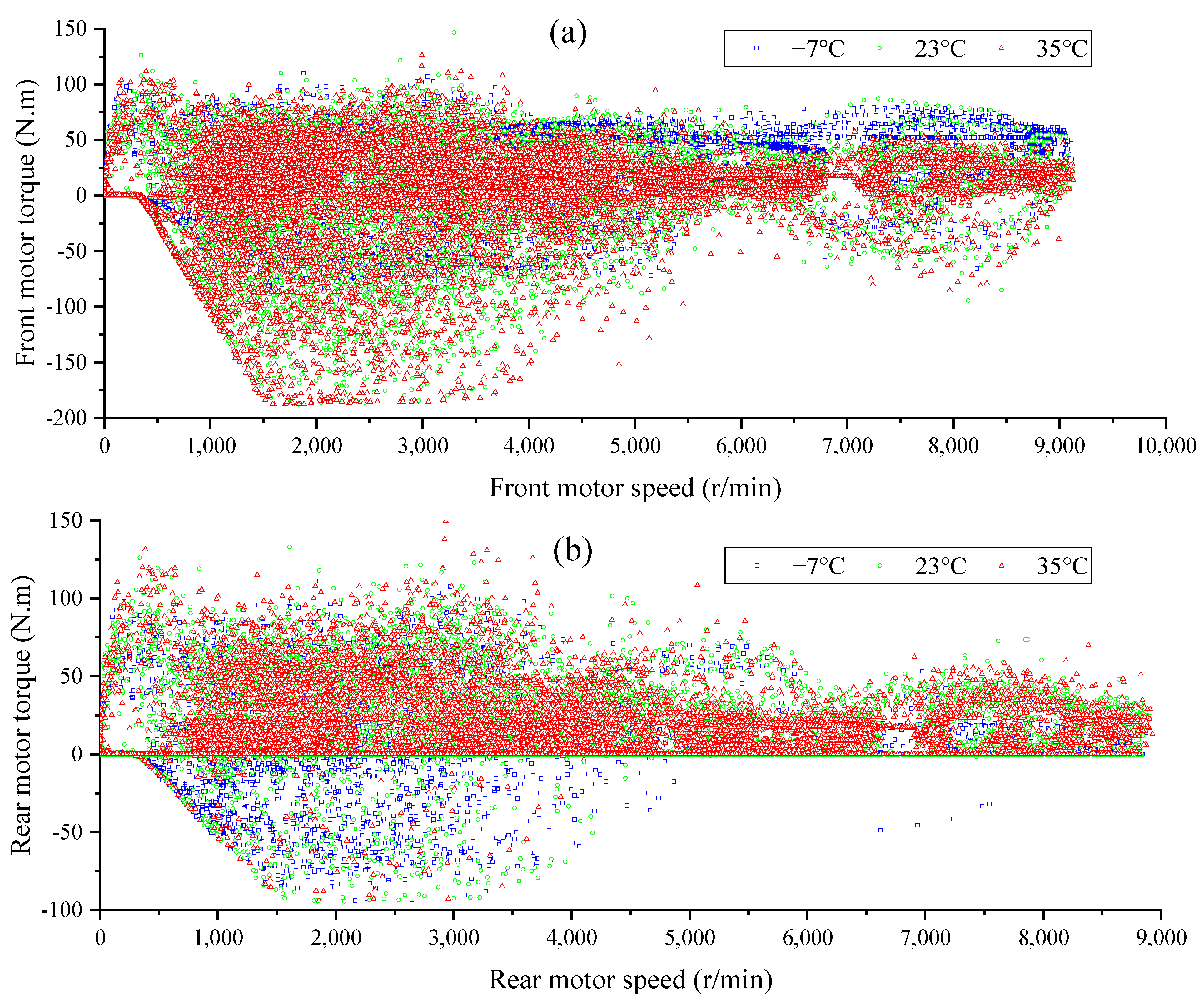A Comparative Study on the Energy Flow of Electric Vehicle Batteries among Different Environmental Temperatures
Abstract
:1. Introduction
2. Energy Flow Experiment
2.1. Experiment Platform
2.2. Energy Flow Test
2.3. Test Cycles
3. Results and Discussion
3.1. Energy Consumption Distribution
3.2. Key Component Operation Condition and Efficiency
4. Conclusions
Author Contributions
Funding
Data Availability Statement
Conflicts of Interest
Nomenclature
| Acronyms | |
| CAN | Controller area network |
| CO | Carbon monoxide |
| EV | Electric vehicle |
| GHG | Global greenhouse gas |
| HC | Unburned hydrocarbon |
| MCU | Motor control unit |
| NOx | Nitrogen oxides |
| PM | Particulate matter |
| PTC | Positive temperature coefficient |
| SOC | State-of-charge |
| WLTC | Worldwide Light duty test cycle |
References
- Yuan, S.; Lei, W.; Liu, Q.; Liu, R.; Liu, J.; Fu, J.; Han, Y. Distribution and environmental impact of microalgae production potential under the carbon-neutral target. Energy 2022, 263, 125584. [Google Scholar] [CrossRef]
- Feng, R.; Hu, X.; Li, G.; Sun, Z.; Ye, M.; Deng, B. Exploration on the emissions and catalytic reactors interactions of a non-road diesel engine through experiment and system level simulation. Fuel 2023, 342, 127746. [Google Scholar] [CrossRef]
- Wang, H.; Zheng, T.; Sun, W.; Khan, M.Q. Research on the pricing strategy of park electric vehicle agent considering carbon trading. Appl. Energy 2023, 340, 121017. [Google Scholar] [CrossRef]
- Sun, X.; Xie, M.; Zhou, F.; Wu, X.; Fu, J.; Liu, J. Hierarchical evolutionary construction of neural network models for an Atkinson cycle engine with double injection strategy based on the PSO-Nadam algorithm. Fuel 2023, 333, 126531. [Google Scholar] [CrossRef]
- Lin, Z.; Wang, P.; Ren, S.; Zhao, D. Comprehensive impact assessment of carbon neutral pathways and air pollution control policies in Shaanxi Province of China. Resour. Conserv. Recycl. Adv. 2023, 18, 200143. [Google Scholar] [CrossRef]
- Shafique, M.; Luo, X. Environmental life cycle assessment of battery electric vehicles from the current and future energy mix perspective. J. Environ. Manag. 2021, 303, 114050. [Google Scholar] [CrossRef] [PubMed]
- European Environment Agency (EEA). Transport and Environment Statistics: Autumn 2021. Available online: https://www.gov.uk/government/statistics/transport-and-environment-statistics-autumn-2021/transport-and-environment-statistics-autumn-2021#main-findings (accessed on 19 October 2021).
- China Mobile Source Environmental Management Annual Report, Ministry of Ecology and Environment of the People’s Republic of China. 2022. Available online: https://www.mee.gov.cn/hjzl/sthjzk/ydyhjgl/202212/W020221207387013521948.pdf (accessed on 7 December 2022). (In Chinese)
- Duan, X.; Liu, Y.; Liu, J.; Lai, M.-C.; Jansons, M.; Guo, G.; Zhang, S.; Tang, Q. Experimental and numerical investigation of the effects of low-pressure, high-pressure and internal EGR configurations on the performance, combustion and emission characteristics in a hydrogen-enriched heavy-duty lean-burn natural gas SI engine. Energy Convers. Manag. 2019, 195, 1319–1333. [Google Scholar] [CrossRef]
- Duan, X.; Xu, L.; Jiang, P.; Lai, M.-C.; Sun, Z. Parallel perturbation analysis of combustion cycle-to-cycle variations and emissions characteristics in a natural gas spark ignition engine with comparison to consecutive cycle method. Chemosphere 2022, 308, 136334. [Google Scholar] [CrossRef]
- Hardman, S.; Chandan, A.; Tal, G.; Turrentine, T. The effectiveness of financial purchase incentives for battery electric vehicles—A review of the evidence. Renew. Sustain. Energy Rev. 2017, 80, 1100–1111. [Google Scholar] [CrossRef]
- Wu, Y.A.; Ng, A.W.; Yu, Z.; Huang, J.; Meng, K.; Dong, Z. A review of evolutionary policy incentives for sustainable development of electric vehicles in China: Strategic implications. Energy Policy 2020, 148, 111983. [Google Scholar] [CrossRef]
- Tang, A.; Yao, L.; Gong, P.; Jiang, Y. Lithium-ion battery state-of-charge estimation of an order-reduced physics-based model in electric vehicles considering erroneous initialization. Int. J. Energy Res. 2021, 46, 3529–3538. [Google Scholar] [CrossRef]
- Alabi, T.M.; Lu, L.; Yang, Z. Improved hybrid inexact optimal scheduling of virtual powerplant (VPP) for zero-carbon multi-energy system (ZCMES) incorporating Electric Vehicle (EV) multi-flexible approach. J. Clean. Prod. 2021, 326, 129294. [Google Scholar] [CrossRef]
- Chen, Y.; Huang, M.; Tao, Y. Density-based clustering multiple linear regression model of energy consumption for electric vehicles. Sustain. Energy Technol. Assess. 2022, 53, 102614. [Google Scholar] [CrossRef]
- Hasan, S. Assessment of electric vehicle repurchase intention: A survey-based study on the Norwegian EV market. Transp. Res. Interdiscip. Perspect. 2021, 11, 100439. [Google Scholar] [CrossRef]
- International Energy Agency (IEA). Global EV Outlook 2023. Available online: https://www.iea.org/events/global-ev-outlook-2023 (accessed on 26 April 2023).
- Yu, Q.; Huang, Y.; Tang, A.; Wang, C.; Shen, W. OCV-SOC-Temperature Relationship Construction and State of Charge Estimation for a Series–Parallel Lithium-Ion Battery Pack. IEEE Trans. Intell. Transp. Syst. 2023, 24, 6362–6371. [Google Scholar] [CrossRef]
- Chen, R.; Qian, X.W.; Miao, L.X.; Ukkusuri, S.V. Optimal charging facility location and capacity for electric vehicles considering route choice and charging time equilibrium. Comput. Oper. Res. 2020, 113, 104776. [Google Scholar] [CrossRef]
- Tang, A.; Wang, C.; Zhang, D.; Zhang, K.; Zhou, Y.; Zhang, Z. A multi-model real covariance-based battery state-of-charge fusion estimation method for electric vehicles using ordered weighted averaging operator. Int. J. Energy Res. 2022, 46, 17273–17284. [Google Scholar] [CrossRef]
- Ma, Y.; Ding, H.; Liu, Y.; Gao, J. Battery thermal management of intelligent-connected electric vehicles at low temperature based on NMPC. Energy 2021, 244, 122571. [Google Scholar] [CrossRef]
- Xia, G.; Cao, L.; Bi, G. A review on battery thermal management in electric vehicle application. J. Power Sources 2017, 367, 90–105. [Google Scholar] [CrossRef]
- Huang, D.; Chen, Z.; Zhou, S. Model prediction-based battery-powered heating method for series-connected lithium-ion battery pack working at extremely cold temperatures. Energy 2020, 216, 119236. [Google Scholar] [CrossRef]
- Petzl, M.; Kasper, M.; Danzer, M.A. Lithium plating in a commercial lithium-ion battery—A low-temperature aging study. J. Power Sources 2015, 275, 799–807. [Google Scholar] [CrossRef]
- Li, W.; Liu, Y.; Liu, R.; Wang, D.; Shi, J.; Yu, Z.; Cheng, L.; Chen, J. Performance evaluation of secondary loop low-temperature heat pump system for frost prevention in electric vehicles. Appl. Therm. Eng. 2020, 182, 115615. [Google Scholar] [CrossRef]
- Park, M.H.; Kim, S.C. Heating Performance Enhancement of High Capacity PTC Heater with Modified Louver Fin for Electric Vehicles. Energies 2019, 12, 2900. [Google Scholar] [CrossRef] [Green Version]
- Kebede, M.A.; Phasha, M.J.; Kunjuzwa, N.; le Roux, L.J.; Mkhonto, D.; Ozoemena, K.I.; Mathe, M.K. Structural and electrochemical properties of aluminium doped LiMn2O4 cathode materials for Li battery: Experimental and ab initio calculations. Sustain. Energy Technol. Assess. 2014, 5, 44–49. [Google Scholar] [CrossRef]
- Panchal, S.; Dincer, I.; Agelin-Chaab, M.; Fraser, R.; Fowler, M. Experimental temperature distributions in a prismatic lithium-ion battery at varying conditions. Int. Commun. Heat Mass Transf. 2015, 71, 35–43. [Google Scholar] [CrossRef]
- Al-Wreikat, Y.; Serrano, C.; Sodré, J.R. Effects of ambient temperature and trip characteristics on the energy consumption of an electric vehicle. Energy 2022, 238, 122028. [Google Scholar] [CrossRef]
- Han, S.; Tagayi, R.K.; Kim, J.; Kim, J. Adaptive deterministic approach for optimized sizing of high-energy battery system applied in electric-powered application. Appl. Energy 2022, 309, 118498. [Google Scholar] [CrossRef]
- Li, S.; Xu, L.; Du, X.; Wang, N.; Lin, F.; Abdelkareem, M.A. Combined single-pedal and low adhesion control systems for enhanced energy regeneration in electric vehicles: Modeling, simulation, and on-field test. Energy 2023, 269, 126982. [Google Scholar] [CrossRef]
- Pan, C.; Tao, Y.; Liu, Q.; He, Z.; Liang, J.; Zhou, W.; Wang, L. Grey wolf fuzzy optimal energy management for electric vehicles based on driving condition prediction. J. Energy Storage 2021, 44, 103398. [Google Scholar] [CrossRef]
- Yadlapalli, R.T.; Kotapati, A.; Kandipati, R.; Koritala, C.S. A review on energy efficient technologies for electric vehicle applications. J. Energy Storage 2022, 50, 104212. [Google Scholar] [CrossRef]
- Lai, C.; Shan, S.; Feng, S.; Chen, Y.; Zeng, J.; Song, J.; Fu, L. Numerical investigations on heat transfer enhancement and energy flow distribution for interlayer battery thermal management system using Tesla-valve mini-channel cooling. Energy Convers. Manag. 2023, 280, 116812. [Google Scholar] [CrossRef]
- Sun, X.; Fu, J.; Yang, H.; Xie, M.; Liu, J. An energy management strategy for plug-in hybrid electric vehicles based on deep learning and improved model predictive control. Energy 2023, 269, 126772. [Google Scholar] [CrossRef]
- Dong, H.; Fu, J.; Zhao, Z.; Liu, Q.; Li, Y.; Liu, J. A comparative study on the energy flow of a conventional gasoline-powered vehicle and a new dual clutch parallel-series plug-in hybrid electric vehicle under NEDC. Energy Convers. Manag. 2020, 218, 113019. [Google Scholar] [CrossRef]
- Zhu, G.; Zhen, D.; Chen, W.; Zuo, Q.; Zhao, M.; Wang, Y.; Chen, Z.; Yang, J. Experimental study on the engine energy flow of a heavy-duty vehicle under C-WTVC. Energy Rep. 2022, 8, 4430–4442. [Google Scholar] [CrossRef]
- Li, M.; Xu, H.; Li, W.; Liu, Y.; Li, F.; Hu, Y.; Liu, L. The structure and control method of hybrid power source for electric vehicle. Energy 2016, 112, 1273–1285. [Google Scholar] [CrossRef]
- Danko, M.; Hanko, B.; Drgoňa, P. Optimized Control of Energy Flow in an Electric Vehicle based on GPS. Commun. Sci. Lett. Univ. Zilina 2021, 23, C7–C14. [Google Scholar] [CrossRef]
- Merhy, G.; Nait-Sidi-Moh, A.; Moubayed, N. A multi-objective optimization of electric vehicles energy flows: The charging process. Ann. Oper. Res. 2020, 296, 315–333. [Google Scholar] [CrossRef]
- Schulz-Mönninghoff, M.; Bey, N.; Nørregaard, P.U.; Niero, M. Integration of energy flow modelling in life cycle assessment of electric vehicle battery repurposing: Evaluation of multi-use cases and comparison of circular business models. Resour. Conserv. Recycl. 2021, 174, 105773. [Google Scholar] [CrossRef]
- Bobba, S.; Mathieux, F.; Ardente, F.; Blengini, G.A.; Cusenza, M.A.; Podias, A.; Pfrang, A. Life Cycle Assessment of repurposed electric vehicle batteries: An adapted method based on modelling energy flows. J. Energy Storage 2018, 19, 213–225. [Google Scholar] [CrossRef]
- Xie, Y.; Li, Y.; Zhao, Z.; Dong, H.; Wang, S.; Liu, J.; Guan, J.; Duan, X. Microsimulation of electric vehicle energy consumption and driving range. Appl. Energy 2020, 267, 115081. [Google Scholar] [CrossRef]
- Miri, I.; Fotouhi, A.; Ewin, N. Electric vehicle energy consumption modelling and estimation—A case study. Int. J. Energy Res. 2020, 45, 501–520. [Google Scholar] [CrossRef]
- Qiu, C.; Wang, G. New evaluation methodology of regenerative braking contribution to energy efficiency improvement of electric vehicles. Energy Convers. Manag. 2016, 119, 389–398. [Google Scholar] [CrossRef]
- Apostolaki-Iosifidou, E.; Codani, P.; Kempton, W. Measurement of power loss during electric vehicle charging and discharging. Energy 2017, 127, 730–742. [Google Scholar] [CrossRef]
- GB/T 19233-2020; Measurement Methods of Fuel Consumption for Light-Duty Vehicles. China Standardization Administration. Available online: http://www.gb688.cn/bzgk/gb/newGbInfo?hcno=2CBFC784D82DE14831CB72365B961610 (accessed on 2 June 2020).
- Feng, R.; Chen, K.; Sun, Z.; Hu, X.; Li, G.; Wang, S.; Deng, B.; Sun, W. A comparative study on the energy flow of a hybrid heavy truck between AMT and MT shift mode under local driving test cycle. Energy Convers. Manag. 2022, 256, 115359. [Google Scholar] [CrossRef]
- Yu, J.; Ma, Y.; Yu, H.; Lin, C. Adaptive fuzzy dynamic surface control for induction motors with iron losses in electric vehicle drive systems via backstepping. Inf. Sci. 2017, 376, 172–189. [Google Scholar] [CrossRef]
- Guo, Q.; Zhang, C.; Li, L.; Zhang, J.; Wang, M. Design and Implementation of a Loss Optimization Control for Electric Vehicle In-Wheel Permanent-Magnet Synchronous Motor Direct Drive System. Energy Procedia 2017, 105, 2253–2259. [Google Scholar] [CrossRef]
- Tang, A.; Gong, P.; Huang, Y.; Wu, X.; Yu, Q. Research on pulse charging current of lithium-ion batteries for electric vehicles in low-temperature environment. Energy Rep. 2023, 9, 1447–1457. [Google Scholar] [CrossRef]
- Yu, W.; Wang, R.; Zhou, R. A Comparative Research on the Energy Recovery Potential of Different Vehicle Energy Regeneration Technologies. Energy Procedia 2019, 158, 2543–2548. [Google Scholar] [CrossRef]
- Erhan, K.; Özdemir, E. Prototype production and comparative analysis of high-speed flywheel energy storage systems during regenerative braking in hybrid and electric vehicles. J. Energy Storage 2021, 43, 103237. [Google Scholar] [CrossRef]
- Al-Wreikat, Y.; Serrano, C.; Sodré, J.R. Driving behaviour and trip condition effects on the energy consumption of an electric vehicle under real-world driving. Appl. Energy 2021, 297, 117096. [Google Scholar] [CrossRef]
- Hamada, A.T.; Orhan, M.F. An overview of regenerative braking systems. J. Energy Storage 2022, 52, 105033. [Google Scholar] [CrossRef]
- Wang, F.; Wu, W.; Zhu, Q.; Li, K.; Zhang, H. Experimental study of electronic expansion valve opening on the performance of electric vehicle heat pump system at different compressor speeds. Int. J. Refrig. 2023, 149, 94–104. [Google Scholar] [CrossRef]
- Kwon, K.; Lee, J.-H.; Lim, S.-K. Optimization of multi-speed transmission for electric vehicles based on electrical and mechanical efficiency analysis. Appl. Energy 2023, 342, 121203. [Google Scholar] [CrossRef]
- Atangulova, A.; Komshilov, K.; Sennikova, A.; Barbashov, N.; Shanygin, S.; Lobacheva, E. Method for Recovery of Vehicle Braking Energy with Electric Drive Powered by DC Network and Device for Its Implementation. Transp. Res. Procedia 2023, 68, 967–972. [Google Scholar] [CrossRef]
- Yan, D.; Lu, L.; Li, Z.; Feng, X.; Ouyang, M.; Jiang, F. Durability comparison of four different types of high-power batteries in HEV and their degradation mechanism analysis. Appl. Energy 2016, 179, 1123–1130. [Google Scholar] [CrossRef]
- Snoussi, J.; Ben Elghali, S.; Zerrougui, M.; Bensoam, M.; Benbouzid, M.; Mimouni, M.F. Unknown input observer design for lithium-ion batteries SOC estimation based on a differential-algebraic model. J. Energy Storage 2020, 32, 101973. [Google Scholar] [CrossRef]
- Wei, D.; He, H.; Cao, J. Hybrid electric vehicle electric motors for optimum energy efficiency: A computationally efficient design. Energy 2020, 203, 117779. [Google Scholar] [CrossRef]











| Component | Item | Content |
|---|---|---|
| Vehicle | Type | Five-door and five-seat passenger car |
| Mass (kg) | 2440 | |
| Wheelbase (mm) | 2965 | |
| Drive mode | Electric four-wheel drive | |
| Rolling radius (m) | 0.508 | |
| Transmission type | Single-speed transmission | |
| Transmission ratio | 9.2 | |
| Maximum speed (km/h) | 210 | |
| Motor | Type | Alternating current asynchronous motor |
| Peak power (kW) | 386 | |
| Peak torque (N·m) | 660 | |
| High-voltage battery | Type | Ternary lithium battery |
| Battery capacity (kW·h) | 60 | |
| Rated voltage (V) | 400 |
| Equipment Name | Manufacturer/Type | Measurement Range | Precision |
|---|---|---|---|
| Chassis dynamometer | Horiba VULCAN EMS-CD48L | / | ≤±0.005% FS |
| Torque sensor | Kistler 4503B | 0–5000 N·m | ≤±0.05% FS |
| Current sensor | LEM IT65-S | ±60 A | 0.03% |
| SENADC-301 | ±300 A | 0.03% | |
| HIOKI CT6845-05 | 0–500 A | 0.03% | |
| Voltage sensor | LEM CV 3-1000 | 0–700 V | 0.2% |
| LEM CV3-100/SP3 | 0–200 V | 0.03% | |
| Pressure sensor | MPM4120-3 | 0–3 bar | 0.2% |
| Temperature sensor | Omega TT-K-24-5.0M | −100–260 °C | Ⅰ Grade |
| Flow meter | DM TF-10 | 4.5–60 L/min | ≤±0.05% FS |
| DM TF4-8 | 0–12 L/min | ≤±0.05% FS | |
| Power analyzer | HIOKI PW6001 | 1500 V/300 A | ≤±0.1% FS |
| Data acquisition system | HBM-Quantum X MX840B (100 channels) | / | / |
| Item | −7 °C | 23 °C | 35 °C |
|---|---|---|---|
| Driving mileage (km) | 162.89 | 256.09 | 198.69 |
| Charging capacity (kWh) | 65.2 | 66.1 | 67.4 |
| Power consumption rate (kWh/100 km) | 40.03 | 25.81 | 33.92 |
| Duration of test (s) | 12,469 | 19,654 | 15,599 |
| WLTC cycle number (-) | 6.93 | 10.92 | 8.67 |
Disclaimer/Publisher’s Note: The statements, opinions and data contained in all publications are solely those of the individual author(s) and contributor(s) and not of MDPI and/or the editor(s). MDPI and/or the editor(s) disclaim responsibility for any injury to people or property resulting from any ideas, methods, instructions or products referred to in the content. |
© 2023 by the authors. Licensee MDPI, Basel, Switzerland. This article is an open access article distributed under the terms and conditions of the Creative Commons Attribution (CC BY) license (https://creativecommons.org/licenses/by/4.0/).
Share and Cite
Zhao, Z.; Li, L.; Ou, Y.; Wang, Y.; Wang, S.; Yu, J.; Feng, R. A Comparative Study on the Energy Flow of Electric Vehicle Batteries among Different Environmental Temperatures. Energies 2023, 16, 5253. https://doi.org/10.3390/en16145253
Zhao Z, Li L, Ou Y, Wang Y, Wang S, Yu J, Feng R. A Comparative Study on the Energy Flow of Electric Vehicle Batteries among Different Environmental Temperatures. Energies. 2023; 16(14):5253. https://doi.org/10.3390/en16145253
Chicago/Turabian StyleZhao, Zhichao, Lu Li, Yang Ou, Yi Wang, Shaoyang Wang, Jing Yu, and Renhua Feng. 2023. "A Comparative Study on the Energy Flow of Electric Vehicle Batteries among Different Environmental Temperatures" Energies 16, no. 14: 5253. https://doi.org/10.3390/en16145253
APA StyleZhao, Z., Li, L., Ou, Y., Wang, Y., Wang, S., Yu, J., & Feng, R. (2023). A Comparative Study on the Energy Flow of Electric Vehicle Batteries among Different Environmental Temperatures. Energies, 16(14), 5253. https://doi.org/10.3390/en16145253





